
The Mount of Olives or Mount Olivet is a mountain ridge in East Jerusalem, east of and adjacent to Jerusalem's Old City. It is named for the olive groves that once covered its slopes. The southern part of the mount was the Silwan necropolis, attributed to the elite of the ancient Kingdom of Judah. The western slopes of the mount, those facing Jerusalem, have been used as a Jewish cemetery for over 3,000 years and holds approximately 150,000 graves, making it central in the tradition of Jewish cemeteries. Atop the hill lies the Palestinian neighbourhood of At-Tur, a former village that is now part of East Jerusalem.

Beit She'an, also Beth-shean, formerly Beisan, is a town in the Northern District of Israel. The town lies at the Beit She'an Valley about 120 m below sea level.

Mazkeret Batya is a local council in central Israel located southeast of Rehovot and 25 kilometres (16 mi) from Tel Aviv. Mazkeret Batya spans an area of 7,440 dunams (7 km²). In 2022 it had a population of 15,726. The mayor of Mazkeret Batya is Gaby Gaon.

The history of the Jews in Indonesia began with the arrival of early European explorers and settlers, and the first Jews arrived in the 17th century. Most Indonesian Jews arrived from Southern Europe, the United Kingdom, the Netherlands, Belgium, Germany, France, the Middle East, North Africa, India, China, and Latin America. Jews in Indonesia presently form a very small Jewish community of about 100–550, of mostly Sephardi Jews. Judaism is not recognized as one of the country's six major religions, however its practices are allowed under Perpres 1965 No. 1 and article 29 paragraph 2 of Constitution of Indonesia. Therefore, members of the local Jewish community have to choose to register as "Belief in One Almighty God" or another recognized religions on their official identity cards.

Obrzycko is a town in Szamotuły County, Greater Poland Voivodeship, Poland, with 2,262 inhabitants (2010).
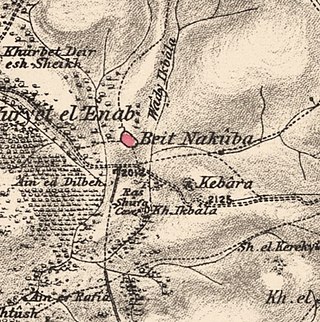
Bayt Naqquba was a Palestinian village in British Mandate Palestine, located 9.5 kilometers west of Jerusalem, near Abu Ghosh. Before Palmach and Haganah troops occupied the village during Operation Nachshon on April 11, 1948, approximately 300 Palestinian Arabs lived there. After the 1948 Arab–Israeli War, a moshav named Beit Nekofa was founded close to the site by Jewish immigrants from Yugoslavia. In 1962, residents of Bayt Naqubba built a new village named Ein Naqquba, south of Beit Nekofa.

Har HaMenuchot is the largest cemetery in Jerusalem. The hilltop burial ground lies at the western edge of the city adjacent to the neighborhood of Givat Shaul, with commanding views of Mevaseret Zion to the north, Motza to the west, and Har Nof to the south. Opened in 1951 on 300 dunams of land, it has continually expanded into new sections on the northern and western slopes of the hill. As of 2008, the cemetery encompasses 580 dunams in which over 150,000 people are buried.

The Remah Synagogue is a 16th-century Jewish synagogue and the smallest of all historic synagogues in the Kazimierz district of Kraków, Poland. The synagogue is named after Rabbi Moses Isserles (c.1525–1572), known by the Hebrew acronym ReMA who's famed for writing a collection of commentaries and additions that complement Rabbi Yosef Karo's Shulchan Aruch, with Ashkenazi traditions and customs. It is currently one of two active synagogues in the city.

Beit She'arim necropolis is an extensive necropolis of rock-cut tombs near the remains of the ancient Jewish town of Beit She'arim. In early modern times the site was the Arab village of Sheikh Bureik; it was depopulated in the 1920s as a result of the Sursock Purchases, and identified as Beit She'arim in 1936 by historical geographer Samuel Klein.

A Jewish cemetery is a cemetery where Jews are buried in keeping with Jewish tradition. Cemeteries are referred to in several different ways in Hebrew, including beit kevarot, beit almin or beit olam [haba],, the beit chayyim and beit shalom.

The history of the Jews in Sudan goes back to a small but vibrant community of Jews who lived there from about 1885 to around 1970. Most of the community left for Israel or Europe after anti-Semitic attacks began to spread against both the Jews in Israel and those still living in Sudan.
The history of the Jews in Omaha, Nebraska, goes back to the mid-1850s.

The history of Jews in Thailand began in the 18th century with the arrival of Baghdadi Jewish families and Jewish peoples from Europe during Napoleonic era (1799-1815).
The House of Hillel and House of Shammai were, among Jewish scholars, two schools of thought during the period of tannaim, named after the sages Hillel and Shammai who founded them. These two schools had vigorous debates on matters of ritual practice, ethics, and theology which were critical for the shaping of the Oral Law and Judaism as it is today.
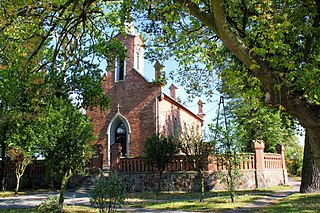
Osięciny is a village in Radziejów County, Kuyavian-Pomeranian Voivodeship, in north-central Poland. It is the seat of the gmina called Gmina Osięciny. It lies approximately 14 kilometres (9 mi) east of Radziejów and 45 km (28 mi) south of Toruń.
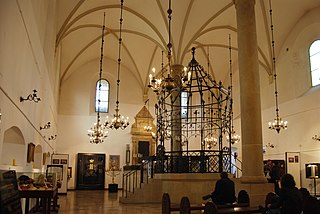
The synagogues of Kraków are a collection of monuments of Jewish sacred architecture in Poland. The seven main synagogues of the Jewish District of Kazimierz constitute the largest such complex in Europe next to Prague. These are:
- The Old Synagogue
- Wolf Popper Synagogue
- Remah Synagogue
- High Synagogue
- Izaak Synagogue
- Temple Synagogue
- Kupa Synagogue
The history of the Jews in Munich, Germany, dates back to the beginning of the 13th century. An early written reference to a Jewish presence in Munich is dated 1229, when Abraham de Munichen acted as a witness to the sale of a house in Ratisbon.
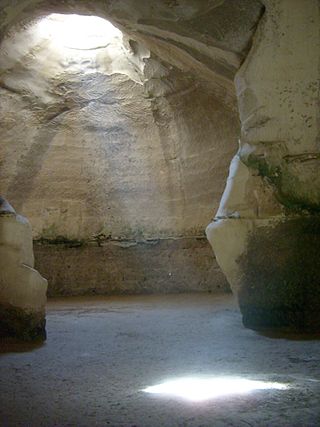
Beit Guvrin-Maresha National Park is a national park in central Israel, containing a large network of caves recognized by UNESCO as a World Heritage Site. The national park includes the remains of the historical towns of Maresha, one of the important towns of Judah during the First Temple Period, and Bayt Jibrin, a depopulated Palestinian town known as Eleutheropolis in the Roman era. However, Maresha and Bayt Jibrin are not part of the UNESCO site, which covers only the cave network.

Beit Jimal, Beit el Jemâl, meaning "The house of the camel" is a Catholic monastery run by Salesian priests and brothers near Beit Shemesh, Israel. The Christian tradition identifies the site with the Roman- and Byzantine-era Jewish village of Caphargamala, and believe that a cave there is the tomb of St. Stephen or to have conserved his relics. An alternative spelling and etymology for the name is therefore Beit Gemal or Beit Gamal - the House of Rabban Gamaliel the Elder.
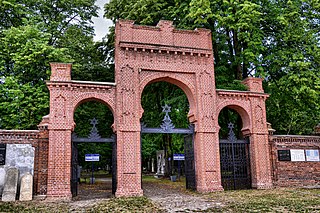
The Łódź Jewish Cemetery, also known as the New Jewish Cemetery, was once the largest Jewish cemetery in Poland and one of the largest in the world. Located in the city of Łódź on Bracka Street, the necropolis was opened in 1892 and occupies around 44 hectares of land. The cemetery contains from 180,000 to 230,000 marked graves, as well as mass graves of victims of the Litzmannstadt Ghetto and the Holocaust. From 1893 to 1896, the basic construction of the necropolis was completed under the supervision of well-known architect Adolf Zeligson.